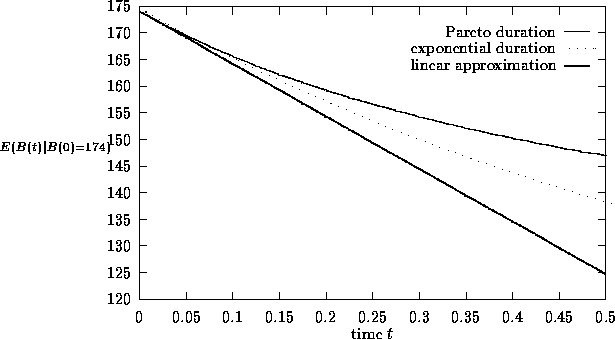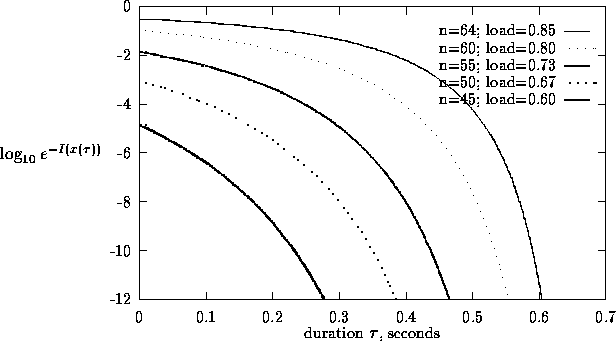
| E(B(t)|B(0) = x) = x + tr (x) , | (44) |

Suppose the service capacity is c>E(B(0)) and we condition on B(0)>c. If r(B(0))<0, we can use (50) to approximate the first time to return to c, the recovery time, by
| |
(45) |
Now suppose that there are n independent sources.
Then as in [10],
it follows
by use of an appropriate functional law of large numbers that,
as ![]() under regularity conditions,
the stochastic paths of the B process converge to this mean path.
Thus we can identify, asymptotically as
under regularity conditions,
the stochastic paths of the B process converge to this mean path.
Thus we can identify, asymptotically as ![]() , t=0 as a hitting time
for the level x.
Thus, we can use (43)
to approximate the probability of this hitting time and
, t=0 as a hitting time
for the level x.
Thus, we can use (43)
to approximate the probability of this hitting time and ![]() in (51)
to approximate
the associated recovery time.
in (51)
to approximate
the associated recovery time.
Example 7.1.
Consider homogeneous two-level sources,
i.e., ![]() ,
, ![]() , p1+p2=1 with mean lifetimes
m1,m2, and P11=P22=1-P12=1-P21=0.
With n sources and B(0)=x we can calculate the
, p1+p2=1 with mean lifetimes
m1,m2, and P11=P22=1-P12=1-P21=0.
With n sources and B(0)=x we can calculate the ![]() in (47)
directly from the relation
in (47)
directly from the relation ![]() for
for ![]() .
Then
.
Then
| 2|c| # sources | initial | steady-state | 3c|recovery time |
|||
| 2|c|initially in | total | probability | 2c|inversion | |||
| 2|c|each level | demand | of x | linear | exponential | Pareto | |
| n1 | n2 | x | e-I(x) | approx. | duration | duration |
| 25 | 25 | 150 | ||||
| 22 | 28 | 162 | 0.15 | 0.16 | 0.19 | |
| 19 | 31 | 174 | 0.24 | 0.29 | 0.41 | |
| 16 | 34 | 186 | 0.31 | 0.41 | 0.64 | |
| 13 | 37 | 198 | 0.37 | 0.50 | 0.91 |
We present in Table 1 some values of n1 , n2,
the number of sources in each level for a given x, the approximate
probability e-I(x) of demand exceeding x (using I from (45)),
and ![]() . For comparison we give also
the exact recovery time for the mean, calculated by using numerical
transform inversion methods [1], for
particular models of level durations with the same means:
(i) both level durations exponentially distributed;
(ii) lower level exponential, upper level duration Pareto with exponent 1.5,
and hence ccdf Gc(x)=(1+2x)-3/2 in order to give mean m2=1.
The Pareto density g(x) = a(1+x)-(1+a)
has Laplace transform
. For comparison we give also
the exact recovery time for the mean, calculated by using numerical
transform inversion methods [1], for
particular models of level durations with the same means:
(i) both level durations exponentially distributed;
(ii) lower level exponential, upper level duration Pareto with exponent 1.5,
and hence ccdf Gc(x)=(1+2x)-3/2 in order to give mean m2=1.
The Pareto density g(x) = a(1+x)-(1+a)
has Laplace transform ![]() , where
, where ![]() is the incomplete gamma function
is the incomplete gamma function
| |
(46) |
 |
In Figure 3 we display the evolution of the conditioned mean in the linear approximation, and for the two distributions above with the same mean. As should be expected, the linear approximation is more accurate when the initial level x is closer to the capacity c. The linear approximation also behaves worse for the Pareto high-level durations than for the exponential high-level durations. The linear approximation tends to consistently provide a lower bound on the true recovery time for the mean. Even though the linear-approximation estimate of the recovery time diverges from the true mean computed by numerical inversion as the hitting level x increases, the probability of such high x can be very small. Even the largest errors in predicted recovery times in Table 1 are within one order of magnitude, and so might be regarded as suitable approximations. >From our experiments, we conclude that the linear approximation is a convenient rough approximation, but that the numerical inversion yields greater accuracy.
Simple criteria for link dimensioning.
A key point is the two-dimensional characterization
of rare congestion events in terms of likelihood and recovery
time.
To further show how this perspective can be exploited, we plot in
Figure 4,
for various offered loads, the approximate probability ![]() of
a demand at least
of
a demand at least ![]() as a function of
as a function of ![]() , where
, where ![]() ; i.e.,
; i.e., ![]() is the demand from which the recovery time to
the level c is
is the demand from which the recovery time to
the level c is ![]() , using the linear approximation.
Figure 4 shows that the two criteria together impose more constraints on what
sets of sources are acceptable.
Expressed differently, for the same
probability of occurrence, rare congestion events can have
very different recovery times.
, using the linear approximation.
Figure 4 shows that the two criteria together impose more constraints on what
sets of sources are acceptable.
Expressed differently, for the same
probability of occurrence, rare congestion events can have
very different recovery times.
 |